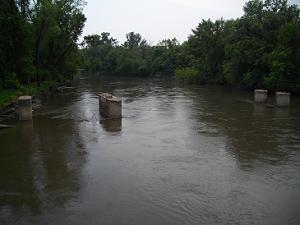Floods of 1993
Tama county, Iowa
The floods of 1993 hit Iowa, and the rest of the Midwest, hard. Chelsea, Iowa is used to the rising Iowa River, but the floods of ’93 were unlike anything seen before. For 37 days, the majority of the town was underwater; meals had to be delivered by boat to residents. With less than 200 houses in town, 85 percent of homes were swamped with water.
Flooding is a common occurrence in the Tama County town. In 1991, it flooded twice. In 1993, the town saw four separate instances of flooding. By the end of the year, the townspeople were ready to take action.
Nearly $7 million in federal assistance was made available to Chelsea to move the existing 132 houses in the floodplain to a vacant lot uphill. The feelings were mixed. The town had existed by the Iowa River for over 100 years, but some residents were ready to make the move.
“This needs to be done,” said resident Todd Banes. “The money is here now, and we might as well do something about it.”
In 1994, the City Council voted 3-1 to accept the offer for federal assistance. However, the plan never fully came to fruition. Difficulties moving prevented most homeowners from actually moving their lives uphill.
Mayor Roger Ochs – a Councilman at the time of the vote – noted that no one in Chelsea had died from flooding since 1944. He continued, “There were comments made at the time [of the vote], ‘Why would anybody want to live there?’ ‘Why would anybody stay there?’ Well, this town is safe and quiet. Many had lived in their houses for years. Most people in town preferred to stay where they were.”
“The water, it’s not life threatening here. That’s what I can’t get across to people in the news,” commented Mayor Ochs.
Mr. Behounek, a Chelsea resident, said about himself and his wife during the relocation period, “We were both hurt. We were divided about what to do. But I didn’t want to reinvest in a house at my age. I’m 56, and I had a livestock operation near town. My plans now are to study the damage and evaluate.”

Image Source: NWS
The owners of more than 40 houses left Chelsea. Some stayed for the town and its history; others stayed because the move, while enticing, proved to be a challenge. Conflicting information and multiple agencies made the process too confusing and challenging for most residents to move their homes.
Mayor Ochs commented on the disappointment he felt that FEMA had not given more people the option of elevating their houses. “I’d like to see a program initiated that would elevate homes for people who want to do it,” he said. “Then, 99 percent of the homes would be over the floodplain.”
Kurt Kelley, a volunteer firefighter, commented, “I moved here. I knew Chelsea floods. It didn’t deter me.” He purchased his home in the floodplain in 1994. His attitude towards the flooding reflects much of the rest of the residents. While flooding is an inconvenience, Chelsea is worth the trouble.
“It’s a beautiful old home, and right now I only have flooding in my basement,” he said. “I would have been really sad if it got to my first floor. But in general, water doesn’t bother me.”
Sources: on-line: Saulny, Susan, “A Town That Looked at Leaving the Floodplain but Stayed On,” The New York Times, 2008; “The Story of Chelsea, Iowa,” Tama County Iowa, 2011; “Town of Chelsea, Iowa, Votes to Relocate to Escape Flooding,” Chicago Tribune, 1994.
